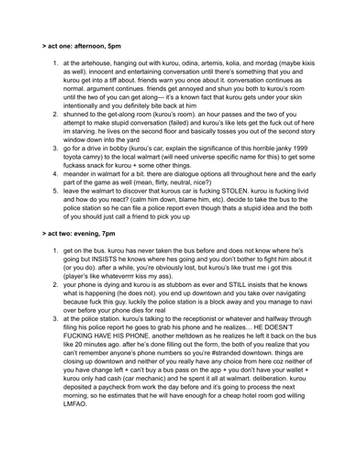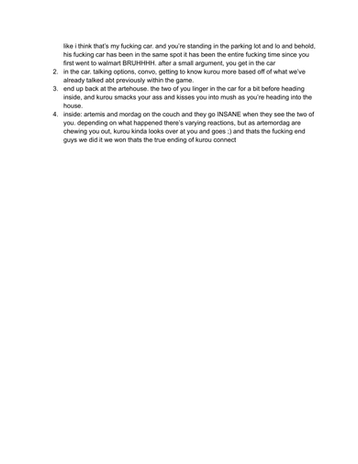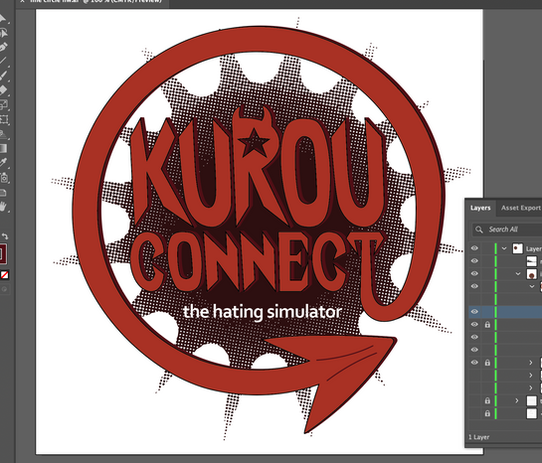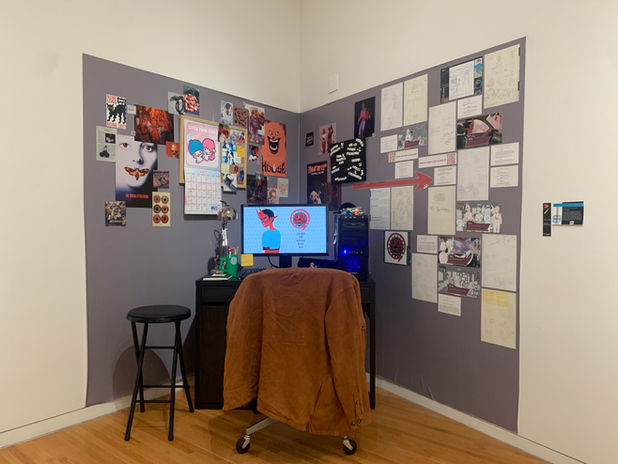
kurou connect
digital video game, ren'py, 2024
kurou connect is a frenemies-to-lovers dating simulator that uses popular fanfiction tropes and forced proximity with the main character to develop an experience of relationship dynamics, character exploration, and short-term narrative in an in-game duration of 24 hours. it was created for my bachelor's in fine arts undergraduate thesis, and the demo of the first act was released on itch.io on april 10th, 2024. it's the spiritual sequel of cryptid coffeehouse (2022), a slow burn dating simulator revolving around humanized nonbinary mothman. the demo is approximately 20% of the full game, being 1 out of the 5 acts that create a single, full route cycle. there are currently 5 routes planned, and the first act is shared between all five routes.
this game had mentally been in development for years prior to its physical form. on august 10th, 2022, i had a conversation in twitter dms with my friend kye about a theoretical game i wanted to create about kurou hasegawa, a side character within cryptid coffeehouse. it was intended to be a "be forced to spend a day with kurou" type of game, and the work hasn't strayed far from that idea at all.
screenshots of the twitter conversation i had with kye back in 2022
when thinking about what to do for my thesis, i knew that i wanted to make a video game. since my practice is centered around the experiences and narratives provided by video games, it was important for me to bring my collegiate career to an end with what i do best. after spending over two years developing cryptid coffeehouse, i had honed my skillset and had a significant amount of technical knowledge that could be applied to creating a new game. even while developing cryptid coffeehouse, i knew i wasn't finished with the game's world in any sense. the characters i created for cryptid coffeehouse are all so nuanced and require attention drawn to each of them individually, so i had already been considering several spinoff games in response to cryptid coffeehouse. however, my decision to make a game about kurou was solidified by the continuous love that fans seem to have for him. aside from artemis, being cryptid coffeehouse's main character and love interest, kurou was always the second most popular character, a fact that confused me for a while. i realized that players were drawn to him not only because of his thorny personality but also because they felt like he had more love and kindness hidden away somewhere behind his aggressive facade. as the months and years dragged on during my cryptid coffeehouse development stage, i started to mentally develop a wealth of character information about kurou, creating family members, memories, relationships, and interpersonal dynamics for him. he quickly began to rival artemis for character lore, so i knew i had to make good on the game i had detailed to kye all that time ago.
the biggest challenge in creating this game was the amount of time provided to me— i was to make a game in four months and it had to be done well. it had to be the best game that i could possibly create. initially, the entire 24-hour act cycle of the "true" route was going to be created, but i quickly realized that wouldn't be feasible. even though i was going to be moving much faster than i had been when creating cryptid coffeehouse, i was still making a game from scratch. because of this, i decided to create a demo of the first act of the true ending so i could hone in on making every aspect hit hard for players.
first, i created a document to streamline my thoughts, feelings, goals, and intentions with the work. this documentation was compounded on throughout the semester and was shared with professors, classmates, and my eventual collaborators. i detailed specific aspects of the game i wanted to hit, artists to look at, medias to consume, tasks to complete not only for the game but also for the imminent installation that would come with it for my solo thesis show... this document had it all.
images of the comprehensive document i used to plan out a large majority of the game's inspirations and inner workings, plus suggestions on artists and medias from my professors and classmates
the next step was to develop the outline of what i was going to write for this build. i initially wrote an outline that specifically detailed all of the events i talked to kye about in 2022, but not only would it have been incredibly difficult to write in four months, it was also hard to piece together. i then wrote a second outline that was more succinct. it was after this that i chose to write just the first act, rather than the wrote true ending. this way, i could focus on making the game well-crafted in every sense, not sacrificing one element for another. additionally, the first act would leave a very good drop-off point for the demo, allowing players to explore the world and their dynamic with kurou, then amp up the anticipation after something shocking happens at the end of the playthrough.
the full revised outline of the true ending of kurou connect
once this was done, it was time to begin the narrative. when i create my video games, i always write the story and dialogue first so that i can create the visuals in response to it. after 41 days, the script was complete, totaling just over 11,400 words. this clocked the game in with a 30-minute playtime, give or take.
snippets of the kurou connect script
with the script being completed, it checked off about 50% of the game's development. what needed to be done now was the visuals. i picked sketching in a sketchbook back up in this semester, something i hadn't had the time or energy to do for the past several years, and i spent a significant amount of time using my sketches as a way to think about what sort of visuals the game required, both in user interface and character art. i additionally used my sketchbook to write notes about specific aspects of the game, such as the music, sound effects, and backgrounds, as well as using it as a checklist and reflection space. this proved to be extremely effective. i was able to think about other facets of the game while simultaneously working on the script, allowing me to create succinctly blend everything together.
my sketchbook pages!
i planned to work with a background artist early on in the process of developing kurou connect. one thing i discovered while making cryptid coffeehouse was that i hated drawing backgrounds. i used edited images that were taken by myself, friends, and family members as scene backdrops in cryptid coffeehouse and i really wanted to shift from that this time around. i was mainly considering hiring and collaborating with a local artist that had an interest and skill in drawing backgrounds, but in a completely unrelated conversation, a discord mutual of mine slid over the portfolio of robin yao. after looking at their portfolio, i knew that i had to work with them. after some correspondence, i solidified their participation in kurou connect. this was great for me as it took a huge part of the artwork creation off of my hands, and i knew that robin was going to be able to do good work. i developed better art direction skills through this collaboration, which is something i'm going to be holding close to me and growing moving forward.
pages of the background art direction document i made for robin
i worked on the game user interface at the same time as the rest of the character art, as i felt that they were connected in a way that would be hindered if i worked on them separately from each other. a fun part of the process for creating the character sprites specifically was trying to find ways to evoke the cryptid coffeehouse sprites and the characters' individual personalities in a game where the scenarios were different, especially because every character aside from kurou only appears in the first scene of the game. for cryptid coffeehouse fans, it's an exciting discovery to see the characters in a different sort of casual mode in kurou connect.
the kurou connect character sprites. pictured from left to right is mordag, odina, kolia, artemis, and kurou
the game user interface was a thrilling challenge to tackle. i had previously been very satisfied with the gui in cryptid coffeehouse, but at the beginning of the semester i played hatomoa's hatoful boyfriend and fiction factory games' arcade spirits. while hatoful boyfriend isn't a ren'py game like arcade spirits, cryptid coffeehouse, and kurou connect is, i was intrigued by the user interface of the game. in the past of couple of years, i've noticed that ren'py games have a very specific appearance that immediately signals that they're ren'py games. i've come to dislike this to an extent. i wanted to make a user interface for kurou connect that was so customized that it was almost imperceptible to identify what engine it was made in at first glance.
first, i decided to ideate the game's logo as that would set the stage for the rest of the interface. i wanted the logo to feature kurou's little devil tail, as that's one of his defining features, and i wanted the general color palette of it to be red, since that's the color of his skin. i wanted it to be circular in nature to imply the cyclical loop of the gameplay and to draw on the idea of connection. the font was hand-created by me, meant to evoke kurou's sharp and pointy personality and his role in artemis' pop punk/punk rock garage band.
the kurou connect logo development. the video showcases the process of the complex logo, first ideated in black and white. i ended up using the simple design as the window icon once i had added the same color palette to it.
i had ironed out the color palette with the logo, but i didn't want the whole game's interface to just be red. considering that cryptid coffeehouse was a very red game, i wanted it to look distinctly different but still recognizable as part of the same series of games. i was focused on sharp asymmetrical parallelograms, pointy spikes, and five-pointed stars. i chose these shapes because i felt they conveyed (1) the tension of the main character's relationship with kurou, (2) the fierceness and volume of kurou's loud, abrasive personality, and (3) the visual connection between the star tattoos on kurou's abdomen and the user interface, allowing a moment of recognition for players.
because i was hesitant to make the interface entirely red, i decided to integrate pure white, eggplant purple, redwood orange, a chocolatey dark red, and a brighter sienna red into the palette. none of these colors are the exact colors in the logo to prevent sameness, but are similar enough for them to be considered cohesive.
typically, ren'py games have what is called the "quick menu" down at the bottom center of the screen, either directly below or on top of the "say screen," which is the textbox in which dialogue and narration rolls out onto. the existence of this quick menu makes a ren'py game instantly recognizable, so i wanted to remove it entirely to make kurou connect more unique. generally, the quick menu includes the following options:
-
back, which rolls back previous text already clicked through onto the say screen,
-
history, which shows players all of the text that's been clicked through in a separate, scrollable screen,
-
skip, which skips already seen text,
-
auto, which auto-clicks through dialogue and narration after a user-specified period of time to continue,
-
save, which pulls up a new screen in which players can save their game,
-
quick save, which allows players to save without clicking out of the game,
-
quick load, which allows players to load their last quick save without clicking out of the game,
-
and the preferences, which takes players to the preferences screen to customize their experience.
with cryptid coffeehouse, i had the majority of these options in a quick menu at the bottom of my say screen. this time, i got rid of it and made a custom set of menu buttons that activated the core options needed for a visual novel: history, skip, save, load, and settings. the history, save, load, and settings buttons live on the right side of the screen, while the skip button lives on the bottom right corner of the textbox for easy access to skipping.
the early development of the kurou connect game user interface and visuals.
after the core of the in-game user interface was created, it was time to work on the out of game user interface, which includes the main menu (where the player starts the game) and the game menu (which houses different screens inside of it, those being the save/load screens, the about screen, and the settings screen). these screens would evoke all of the design decisions from the in-game user interface to maximize cohesion, but would also be slightly altered so that they would be easy to navigate and understand. i did several sketches of these menus in my sketchbook before deciding on ones that would be the most effective.
there was also a intermediary screen that needed to be created so that players could insert their names, pick their preferred pronouns, and choose the pitch of their character's text beeps. the appearance for that was also drawn from the existing in-game gui. additionally, i also created a splash screen that plays when the game is first started up.
video progress of the out of game menus and screens
a very large part of the game aside from the narrative and visual elements is the sound design. for that, i teamed up with my friend louis, who makes music as gnommen. because kurou connect is radically different than cryptid coffeehouse in tone, a soundtrack full of lo-fi hip-hop wasn't going to cut it. it had to be unique, change with the locations and the fluctuating mood of the narrative. i let louis take the reins on the majority of the audio direction, occasionally steering him in the right way when needed. he ended up creating a 9-track ost, custom text beeps for each character, and a selection of ui sound effects. all of these things were paramount to the culmination of the game, elevating the immersion of the game for the players.
for the soundtrack, we wanted to focus on creating an ost that was trans-diegetic. some tracks, like "artehouse," "tensefr," and "kurou's room," are non-diegetic, meaning that they are tracks that the player hears, but the characters within the game do not. other tracks, like "zwt3," "florstore," and the various outside ambiance tracks, are diegetic, meaning that they are tracks that the characters are hearing in the game, which we as the players are now privy to. by having a trans-diegetic soundtrack, the game becomes more immersive and allows players to feel like they're part of the narrative, while still acknowledging that they're playing a video game.
the text beeps in cryptid coffeehouse were relatively standard, simply being pitch-altered sound bytes of the same beep noise for each character. for kurou connect, louis created text beeps for each character so that the sound of their text rollout evoked the personality, vocal inflection, and tone of the character. for example, mordag is a humanized version of the loch ness monster, so her text beeps are bubbly and sound like they're underwater. kolia has a very dry, monotone personality and speaking voice, so her text beeps reflect that. additionally, three different pitches were created for the player's text beeps, so that the player could choose the pitch of their dialogue and narration at the game's initialization. meanwhile, the ui sounds were designed to be clicky and tactile.
the demo of kurou connect was completed on april 8, 2024. on april 10, 2024, the game was debuted not only online but also at my solo thesis show. since my work is exclusively digital, i had to figure out a way to bring it to life and make my professors, peers, and passersby understand the great amount of work that's required to make a video game. i inevitably decided that i was going to create an installation that not only replicated a space that's within kurou's room in the game, but also provide images of my process and inspiration to give people the full story upon seeing the work.
in kurou connect, there is a point in which the player is locked in kurou's room with him and has a chance to snoop about. upon selecting this option, players are let into some info about kurou's character that is inaccessible otherwise. additionally, just from a single visual glance, the room background contains a wealth of information about him as a person that players often times don't need to do the extra snooping. i wanted to play off of this, so i created a semi-replica of kurou's desk space. this way, real life players would have to step into his world, his room, his space in order to play his game.
i specifically chose the installation to be placed in one of the most high-traffic areas of daap— the daap cafe. because there were so many people around and because the installation was so public, it allowed plenty for plenty of interaction between the game and its players. since in the installation was intriguing, passersby would be curious as to what was going on, then allowing themselves to sit down and play, either alone or with friends. they would then be invited to investigate the process of the game on the other side of the installation, led by the red devil tail wrapping around both sides of the moveable wall. there, they would also find qr codes linking them to the full online build of the game, so that they could play the game in its entirety once they have the time.
the kurou connect install for my solo thesis show
my solo show was over on april 13, 2024, and the next day i took both the physical installation and the digital game down. in the weeks before daapworks, the large multidisciplinary exhibition of all the graduating seniors in daap, i had some edits to make. i allowed both real life and online players to leave me feedback on what they thought of the game via a notebook on the desk of the installation and a google form on the digital kurou connect page. several players left good feedback about features they felt needed to be fixed or added to make the game easier to play and understand. i then created kurou connect v1.0.1. in this small patch, i added the following features to the game:
-
a smaller skip button that reads "skip" on hover, as i noticed players inexperienced with visual novels would often click the skip button to continue dialogue,
-
image buttons for the selectable pronoun and voice pitch text on the character initialization screen, because they were originally text buttons that were too thin and hard to click on,
-
quieter text beeps by default,
-
faster default text rollout, because the previous speed was impossibly slow due to a coding error,
-
enabled rollback, because players expressed the desire to quickly look back at what had been previously said without having to click on the history button,
-
and more save slots, as many players like to save before every choice.
on april 23, 2024, daapworks began. for daapworks, i put up an altered version of the kurou connect installation as well as uploaded version 1.0.1 online for play. during daapworks, kurou connect was given an segd daap honorable mention award.
the daapworks kurou connect installation
when daapworks was over on april 27, 2024, the installation was taken down and the game was once again removed from the web. the game was once again put back online in june 2024 for pride month, then left up indefinitely.
the reception of the game has been overwhelmingly positive from both real life players and online players. fans of cryptid coffeehouse are thrilled to have a chance to once again experience the game's world, and new players are interested in the dynamics posed between kurou and the main character as well as the jaw-dropping cliffhanger at the end of the demo. i plan on continuing development for kurou connect after a couple months of post-graduation normalcy, but i'm buzzing with excitement because the possibilities for this game are truly endless.
to read the thesis paper about this game and my artistic practice, click here!


























